What is the overall goal of your website for multi-vendor marketplaces? Are you making or selling more and more money?
Strange, huh? I’ll elaborate.
The simple question posed in the paragraph is: Which is more essential to you, increasing sales or increasing revenue from your online marketplace site?
You can only make money if you are selling, which seems quite apparent. Are sales therefore more crucial because they provide income automatically?
What if I told you that your marketplace website doesn’t rely just on sales to make money? There are additional revenue creation strategies that might be a crucial component of your business plan. By making money off the services that your marketplace website can provide in addition to the market products, they can run in parallel to the sales.
Here are 5 monetization strategies or revenue-generating models you may implement on your marketplace website to boost your company’s earnings:

1. Advertising Revenue Model
One of the most well-known and established methods of generating cash is advertising. By leasing out advertising space on your website, you can make money. You will be compensated by the websites that display their ads in accordance with the appropriate advertising model. You have a choice between two distinct ad models here:
Cost per Mille (CPM): Also known as “cost per thousand impressions,” CPM is an advertising technique that enables you to charge in accordance with the number of advertisements that are shown to website users.
Cost Per Click (CPC): The CPC model bases its revenue generation on how many times site users click on a specific advertisement.
To provide enough white space for the advertisements to display, you must be careful while designing your website. Otherwise, get in touch with a web designer who will adjust the design to suit your needs for advertising.
2. Sponsored Site Channel Model
Normally, a website that wishes to advertise its content on another website must pay for the right to do so. This revenue model is more of a cost-saving model than a revenue-generation model.
Here, two businesses or websites agree to a “contra-deal” where neither site is required to pay for advertising. As part of a “give and take” arrangement, they promise to promote each other’s content.
3. The Freemium Business Model

This technique is used by several online markets and services to make respectable profits. The main goal of the freemium business model is to offer as many people free services as possible and to entice them to upgrade to the paid version of those same services.
In one strategy, you offer a free trial with restricted access to your users and give them the opportunity to upgrade to the paid service to get the full range of advanced features and access.
For instance, we offer some restricted functionalities to the Free Magento Multi-vendor Marketplace extension indefinitely. Customers have the option of utilizing the free version with restrictions for as long as they like, or they can buy the appropriate OpenCart Multi seller Marketplace plugin, Prestashop Marketplace addon, or Magento Multi vendor Marketplace extension to unlock the full functionalities.
These models can be used to provide some premium services and generate additional cash. You might follow Amazon Prime’s example, which offers free same-day shipping to Prime members.

4. Subscription-Based or Membership-Based Model
One of the first types of revenue-generating was subscription-based, and it is still in use today.
There are countless ways for a marketplace site to use this approach to boost business earnings:
Asking sellers, vendors, and merchants to join a membership in exchange for creating an account as a seller or merchant on your marketplace.
Customers are asked to become members in order to receive perks like free shipping, same-day delivery, shipping package insurance, early access to flash discounts, etc.
Part two of customer membership Marketplaces that offer digital goods like MP3s, videos, software, etc. may use a different type of customer membership. In this case, the premium members would essentially be your only source of revenue generation.
For instance, the Netflix video library only permits subscribers to view the videos. It largely uses a subscription-based business strategy for revenue.
5. Sales Commissions Model
I had to bring up this point, of course. The main method of generating income for many marketplaces is by taking a commission from the seller, vendor, or merchant on their sales.
This model is utilised by the entire community of merchants and retailers. The e-merchants can sell their goods to a wider number of clients. Only how and how much commission sellers must pay to sell on an online marketplace varied.

The difficulties of handling the order processing and inventory control for the two stores previously discouraged e-sellers from multi-channel selling. For eCommerce websites built on CMS systems like Prestashop, Magento, OpenCart, Magento 2, and others, Knowband provides a series of feature-rich marketplace integrators. You can keep your marketplace store in sync with your online shopping sites with the aid of these simple integration options.
The Final Words
The revenue model for sales commissions is more complicated than it first appears. Different markets employ various strategies to generate the commission. Prior to customizing your Seller administration panel to handle commissions as needed, you must first choose the commission model you wish to utilize.
Similar challenges arise when managing several sellers and charging a commission if you run an online marketplace. However, with the aid of different CMS plugins like the Magento multi-vendor marketplace, Prestashop multi-vendor marketplace addon, or OpenCart marketplace module, controlling the commission model becomes simple.
Additionally, you should be aware that the majority of multi-vendor marketplace extensions only enable per-product-sale commission. You may need to install an extension or have the requirements created by a skilled eCommerce development company if you wish to employ any other commission scheme.




